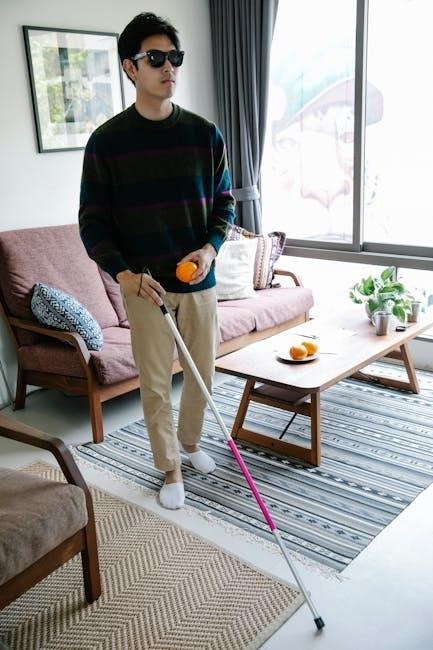visually impaired running guide
Race Day Logistics for Visually Impaired Runners
The race day can be stressful for a visually impaired runner․ Arriving early reduces stress․ Contact the race organizer prior to registering․ Ask about guide registration and VI race divisions․ Locate designated booths with physician or optometrist verification of status․
Understanding Visual Impairment in Runners
Understanding visual impairment is crucial for creating a supportive running environment․ Visual impairment encompasses a range of conditions, not just complete blindness․ It includes varying degrees of reduced vision, such as low vision, blurred vision, and limited field of vision․ Recognizing these differences is essential because each type of visual impairment affects a runner’s experience and abilities differently․
Some runners may have difficulty with depth perception, making it challenging to navigate uneven terrain․ Others may struggle with glare or low light conditions, impacting their ability to run safely at certain times of the day․ Understanding these specific challenges allows guides and coaches to tailor their support and training methods effectively․
Moreover, awareness of the emotional and psychological aspects of visual impairment is vital․ Runners may experience feelings of frustration, anxiety, or isolation due to their vision loss․ Providing encouragement, empathy, and a sense of community can significantly enhance their running journey․ Creating an inclusive and understanding environment fosters confidence and empowers visually impaired runners to achieve their goals․
By recognizing the diverse nature of visual impairment and its impact on runners, we can create a more accessible and supportive running community for everyone․
Benefits of Running for Visually Impaired Individuals
Running offers a multitude of benefits for visually impaired individuals, extending beyond physical fitness․ It promotes overall well-being and enhances quality of life․ Regular running improves cardiovascular health, strengthens muscles, and increases endurance, contributing to better physical health․
Running fosters independence and self-confidence․ Achieving running goals empowers individuals and breaks down barriers․ It creates a sense of accomplishment and personal growth․ Running reduces stress and anxiety․ Physical activity releases endorphins, improving mood and mental well-being․
Running provides opportunities for social interaction and community involvement․ Joining running clubs and participating in races connects individuals with others who share their passion․ This fosters a sense of belonging and reduces social isolation․ Running promotes inclusivity and challenges societal perceptions of disability․

Running demonstrates that visual impairment does not limit one’s ability to achieve athletic goals․ It inspires others and promotes a more inclusive and accepting society․ Running enhances sensory awareness and spatial orientation․ Runners develop a heightened sense of their surroundings, improving their ability to navigate independently․ Running is an adaptable activity, modified to suit individual needs and abilities․

Finding a Guide Runner
Finding a compatible guide runner is crucial for visually impaired individuals who wish to pursue running․ Several avenues can be explored to connect with potential guides․ Local running clubs and organizations are excellent resources․ These groups often have members willing to volunteer as guide runners․
Online platforms and communities dedicated to visually impaired runners can facilitate connections․ These platforms allow individuals to create profiles and search for guides in their area․ Organizations like United In Stride offer programs to match visually impaired runners with guides․
Contacting local adaptive sports organizations can provide access to a network of trained guide runners․ These organizations specialize in providing support and resources for athletes with disabilities․ Universities and colleges with running programs may have students interested in volunteering as guides․

When searching for a guide runner, consider compatibility and shared goals․ It’s essential to find someone with a similar running pace and experience level․ Communication skills and personality are also important factors․ A successful partnership requires trust, patience, and mutual respect․ Trial runs are recommended to assess compatibility before committing to a long-term partnership․ Discuss expectations, goals, and communication preferences․ Ensure that both runner and guide are comfortable with the chosen tether technique․
Communication Techniques Between Runner and Guide
Effective communication is paramount for a safe and successful running partnership between a visually impaired runner and their guide․ Verbal cues are the primary means of conveying information about the surroundings․ The guide should provide clear and concise descriptions of the terrain, obstacles, and upcoming turns․
Descriptive language is essential․ Instead of saying “turn left,” the guide might say, “slight left turn ahead, smooth surface․” The guide should also communicate changes in elevation, such as “slight uphill grade” or “downhill slope approaching․”
Non-verbal cues can supplement verbal communication․ A gentle tug on the tether can indicate a change in direction or the presence of an obstacle․ However, it’s crucial to establish a clear understanding of these non-verbal signals beforehand․
Regular check-ins during the run are important to ensure the runner’s comfort and safety․ The guide should ask the runner about their pace, breathing, and any discomfort they may be experiencing․ The runner should also feel comfortable providing feedback to the guide about the communication style and the level of detail provided․
Practice and open dialogue are key to developing effective communication․ The runner and guide should spend time discussing their preferences and refining their communication techniques․ This will foster trust and ensure a smooth and enjoyable running experience․
Tether Techniques for Guided Running
Tethers are a common and effective tool for connecting a visually impaired runner and their guide․ A tether is a short rope or piece of material, typically around 30 inches long, that allows the guide to provide subtle directional cues and maintain a consistent connection with the runner․
One popular technique involves the guide running slightly ahead and to one side of the runner, with each person holding one end of the tether․ This allows the guide to lead the way while providing verbal directions and using the tether to indicate turns or obstacles․
Another technique involves holding wrists․ You can guide a blind or visually impaired runner by holding their wrist, or by asking them to hold yours․ This can provide a more secure connection, especially in crowded areas or on uneven terrain․
The choice of tether material is important․ It should be comfortable to hold, lightweight, and durable․ Some runners prefer a soft rope, while others prefer a more rigid material․ It’s also important to ensure that the tether is the appropriate length for both the runner and the guide․
Regardless of the specific technique used, it’s crucial to practice using the tether in a safe and controlled environment before running in more challenging conditions; This will allow the runner and guide to become comfortable with the tether and develop a strong sense of coordination․
Safety Considerations for Visually Impaired Runners
Running as a visually impaired individual requires careful attention to safety to mitigate potential risks․ Selecting safe running routes is paramount․ Opt for well-maintained paths with minimal obstacles and predictable surfaces․ Avoid areas with heavy traffic, construction, or uneven terrain․
Communication with your guide runner is critical․ Establish clear signals and verbal cues to alert you to changes in the environment, such as turns, obstacles, or changes in elevation․ Practice these cues in a controlled environment before venturing onto more challenging routes․
Weather conditions can significantly impact safety․ Be mindful of slippery surfaces during rain or snow․ Extreme temperatures can also pose risks, so dress appropriately and adjust your pace accordingly․ Running at night requires extra caution․ Wear reflective gear and consider using a headlamp to enhance visibility․
Awareness of your surroundings is essential, even with a guide․ Pay attention to sounds and other sensory cues that can provide information about your environment․ Be prepared to stop or adjust your course if necessary․
Finally, consider carrying identification and emergency contact information․ A medical alert bracelet can also be helpful in case of an accident․ By taking these precautions, visually impaired runners can enjoy the benefits of running while minimizing potential risks․
Training Tips for Visually Impaired Runners

Effective training for visually impaired runners requires a tailored approach․ Start with a run/walk strategy․ Gradually reduce walking breaks and increase running intervals․ This builds stamina and minimizes injury risk․
Consistency is key․ Establish a regular training schedule and stick to it as much as possible․ This helps your body adapt and improves your overall fitness․
Incorporate varied workouts․ Include interval training, tempo runs, and long runs to challenge different energy systems and improve performance․
Practice running with your guide runner in diverse conditions․ This builds trust and improves communication, essential for safe and effective training․
Focus on proper form․ Work with a coach or experienced runner to identify and correct any biomechanical issues․ This reduces the risk of injury and improves efficiency․
Pay attention to nutrition and hydration․ Fuel your body with a balanced diet and stay hydrated before, during, and after runs․
Listen to your body․ Rest and recover when needed․ Don’t push through pain, as this can lead to injury․
Consider practicing blindfolded with fellow guide runners․ This enhances your understanding of the experience․
Adapt sport lessons to be accessible with resources such as those provided by the Macular Society․
Race Day Logistics for Visually Impaired Runners
Race day logistics can be particularly stressful․ Arriving early helps minimize stress and allows time to familiarize yourself with the surroundings․ Pre-race planning is crucial for a smooth experience․
Contact the race organizer well in advance to discuss specific needs and accommodations․ Inquire about guide runner registration procedures, designated meeting points, and any available assistance․
Clarify rules and regulations regarding visually impaired runners and their guides․ Understand the course layout, including potential hazards and aid stations․
Plan your transportation to and from the race․ Ensure accessible transportation options are available, if needed․
Coordinate with your guide runner to establish clear communication signals and strategies․ Review the course map and discuss potential challenges․
Pack essential items, including hydration, nutrition, and any necessary adaptive equipment․
Familiarize yourself with the race day schedule, including start times, packet pick-up locations, and post-race activities․
Locate designated areas for visually impaired athletes and their guides, such as accessible restrooms and changing facilities․
Bring a physician’s or optometrist’s verification of visual impairment status, if required․
Prepare for varying weather conditions and pack appropriate clothing․
Most importantly, stay calm and focused; Trust in your training and enjoy the experience․
Adaptive Equipment and Technology
Adaptive equipment and technology play a crucial role in enhancing the running experience․ These tools help visually impaired runners overcome challenges and maximize their independence․
Consider using a running tether, a short rope or cord that connects the runner and guide, providing tactile feedback and directional cues․ Experiment with different tether lengths and materials to find what works best․
Explore the use of assistive technologies, such as GPS-enabled watches or smartphone apps that provide real-time audio feedback on pace, distance, and location․ These tools can help runners stay on course and monitor their progress․
Investigate the availability of specialized running shoes or orthotics designed to improve balance and stability․ Consult with a podiatrist or running specialist to determine the best options for your individual needs․
Consider using high-visibility clothing or accessories to enhance safety, especially during low-light conditions․ Reflective vests, armbands, and shoe lights can increase visibility to other runners and vehicles․
Explore the use of audio cues or verbal commands from your guide runner to navigate obstacles and turns․ Clear and concise communication is essential for safe and effective guidance․
Experiment with different types of headphones or earbuds that allow you to listen to music or podcasts while still maintaining awareness of your surroundings․
Consider using a hydration system that allows you to drink water hands-free, such as a hydration pack or belt․
Explore the use of adaptive sunglasses or visors to protect your eyes from sunlight and glare․
Research and experiment with different adaptive equipment and technologies to find what best suits your individual needs and preferences․ Consult with other visually impaired runners or running experts for recommendations and advice․
Resources and Support Organizations
Numerous resources and support organizations exist to empower visually impaired runners and their guides․ These groups offer guidance, training, and community․
United In Stride: Connects visually impaired runners with guides, fostering inclusivity․ They break down barriers, providing stories, tips, and training guides․
Local Running Clubs: Join a local running club for support and training․ Many clubs welcome visually impaired runners and guides, offering a supportive environment․
Adaptive Athletics Organizations: Explore organizations that specialize in adaptive sports․ They provide resources, training, and competitive opportunities for athletes with disabilities․
Online Forums and Communities: Engage with online forums and communities dedicated to visually impaired runners․ Share experiences, ask questions, and connect with others․
Guide Runner Training Programs: Participate in guide runner training programs․ These workshops offer tips and safety for guiding visually impaired runners․
Accessibility Resources: Utilize resources that support accessibility in sports․ These can include adaptive equipment and training materials․
Disability Support Groups: Connect with disability support groups for emotional and practical assistance․ They offer guidance and a sense of community․
Vision Rehabilitation Centers: Consult with vision rehabilitation centers for specialized support and training․ They provide resources and guidance for independent living․
National Sports Organizations: Explore national sports organizations that support athletes with disabilities․ They offer competitive opportunities and resources․
Websites and Blogs: Follow websites and blogs that focus on visually impaired running․ Stay informed about training tips, events, and resources;
